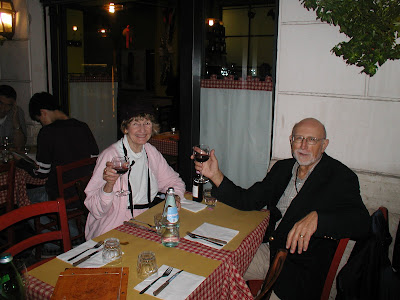

Full of jet lag, we enter the Vatican walls and Saint Peter’s Square. Our first and immediate goal was to tour the Scave. Inside the Vatican and to the south of the main entrances to St. Peter’s Basilica, is The Scave. This an area guarded by Swiss Guards. We were kindly admitted into this gated area by the Swiss Guards. We were trying to determine whether or not we had received reservations to tour The Scave” that we had applied for via the internet. The gentleman at the desk said we had no reservations, but thanks to Joanne’s initiative, we did manage to tag along with another group who had two cancellations.
What is The Scave, one might ask? The Scave is a complex of burial chambers beneath Saint Peter’s. These chambers predate Christianity. Pagans paid to have their ashes or bodies entombed there in niches or elaborate sarcophagi. Saint Peter was buried there- a pauper criminal - in 62 or 64 AD, depending on which guide is telling the story. He was martyred under Nero. The site became holy ground. Some kind of church was built over the tomb and many well to do Christians were buried near him. In the 300s, Constantine built a church on the site.
Evidently Constantine knew where Saint Peter was buried and built the alter over his remains. Then, a thousand years later, the church began to build the present basilica, and the main alter rests upon the alter built by Constantine which in turn rest on top of Saint Peter’s remains.
There is a small pile of yellow bone fragments (maybe a cereal box full) which you can see by bending and peering deep into the recesses of the brick structure. These are said to be the actual bones of Saint Peter, attested by continuous witness transmitted from 62 AD. Of course, in the middle ages there were thousands of such relics; fragments of the true cross, finger bones from various saints, etc. All now held to be fraudulent. And yet this handful of bones survives with enough credibility to move the faithful. You don’t know whether to laugh, cry or fall on your knees.
But as I told Joanne at the outdoor cafe afterwards, that however authentic you think the bones are, they stand as a testimony to the incarnation - the word made flesh. Saint Peter did exist. He did have bones. And so did Jesus. In some fashion, this stuff happened. It isn’t just an idea or a concept, or a metaphor! Somehow this handful of yellow bone fragments has generated six acres of an elaborate basilica,160 acres of surrounding elaborate soaring structures and endless statues, silhouetted against the overcast Roman sky.
And above the labyrinth of narrow passages of the Scave, shuffles the pope, saying mass, and counseling hundreds of millions of the faithful.
“What do you think of Luther now?” I asked Joanne. Remember, Saint Peter’s was built, and the Sistine Chapel painted, and the Pieta carved with money raised from the sale of indulgences.
Part of me understands the frenzied rage with which the reformers smashed the priceless stained glass at Canterbury. “Give me back a Jewish carpenter dying in obscurity on a hill outside Jerusalem!”, they cried. “Give me back a 300 page book I call the Word of God. Give me back simple, modest buildings, where people can sing and pray and study and comfort one another”. We don’t need all this brick and stone and beauty.
Another part of me says, “but we have the brick and stone and might as well enjoy it. It is only brick and stone, but the desire, sacrifice, craft and skill that produced it are connected to that 300 page book and that crude tomb that stood empty one Sunday morning on a date we cannot even fix precisely.
The desire to make beauty is part of what people do to acknowledge and celebrate their salvation and we can be grateful for that - as long as we don’t cut ourselves loose from all that magnificence and begin to think it can do our work for us. Brick and stone cannot read scripture, it cannot pray, or sing or suffer in small communities, and those are the things required. The second picture in this frame is the arch to enter the Vatican Square from the Scave.














